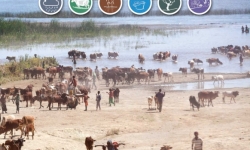CSIR researchers document climate adaptation measures developed by the world’s indigenous communities
For centuries, the world’s indigenous communities have developed climate change mitigation practices that have sustained countless generations. A compendium containing some of these practices will be launched during the Stockholm International Water Institute World Water Week taking place between 25 and 30 August 2019. These age-old practices have been identified as having the potential to be strengthened through modern science.
For centuries, the world’s indigenous communities have developed climate change mitigation practices that have sustained countless generations. A compendium containing some of these practices will be launched during the Stockholm International Water Institute World Water Week taking place between 25 and 30 August 2019. These age-old practices have been identified as having the potential to be strengthened through modern science. The development of the compendium of community and indigenous strategies for climate change adaptation that focuses specifically on addressing water scarcity in agriculture, was led by the CSIR in collaboration with the Food and Agriculture Organization (FAO) of the United Nations.
“Through our experiences in the field, engaging with stakeholders in the agriculture sector and our previous research in the sector, we found that indigenous knowledge plays an important role in sustaining the resilience of social-ecological systems and demands some attention,” says CSIR principal researcher Dr Jean-Marc Mwenge Kahinda, who led the development of the compendium.
“The community-developed strategies have the potential of being strengthened through modern science and technology and this compendium is regarded as a first step at providing a comprehensive listing of indigenous strategies for climate change adaptation that focuses on addressing water scarcity in agriculture,” he says.
There are between 300 and 500 million self-identified indigenous people worldwide – most of whom live in biodiversity hotspots, indicating their ability to protect biodiversity. And even though indigenous people are the ones most affected by climate change, Mwenge Kahinda explains that they hardly ever cause it.
Case studies
The compendium assimilates case studies from around the world, categorised into six technologies and practices themes: Weather forecasting and early warning systems; grazing and livestock management; soil and water management; water harvesting; forest management; and integrated wetlands and fisheries management.
Some of the case studies, taken from the compendium:
Weather forecasting and early warning systems – In Lushoto, Tanzania, the start of short rains is identified by the existence of large flocks of swallows and swans, roaming from the South to the North during the months of September to November.
Grazing and livestock management - The Wodaabe, also known as the Mbororo, a small subgroup of the Fulani ethnic group, use lunar cycles to schedule livestock movements to new pastures. This leads to moving grazing areas every two to three days.
Soil and water management – In the Gwallek–Keda (Baitadi district, Nepal), farmers plant legume crops in paddy fields. They also intercrop soybean with maize and apply farmyard manure to improve soil fertility.
Water Harvesting - In Timor-Leste, local communities dig small holes (“be’e matan/ posu”) next to the river bed to collect clean water. The water seeps through the sand and wells up through the soil.
“Indigenous knowledge is local and specific and the examples highlighted are a reflection of the ability of these communities to cope with the variability of climate change,” says Mwenge Kahinda, emphasising the need to strengthen the dissemination of this knowledge and integrate modern approaches that reinforce indigenous knowledge in climate change adaptation and resilience.
The compendium provides a basis for transferring technologies and practices between areas of similar agro-ecology; and the authors recommend that such transfers are pursued and documented in preparation for wider adoption and upscaling.
The compendium was prepared by Mwenge Kahinda, CSIR senior researcher Karen Nortje, CSIR interns Nwabisa Budaza and Simtholile Mavundla, and CSIR Master’s student Nina Nohayi under the overall supervision and technical guidance of FAO senior land and water officer, Ruhiza Boroto, in close collaboration with FAO natural resources officer Patrick Bahalokwibale.
To access the compendium, click here.



